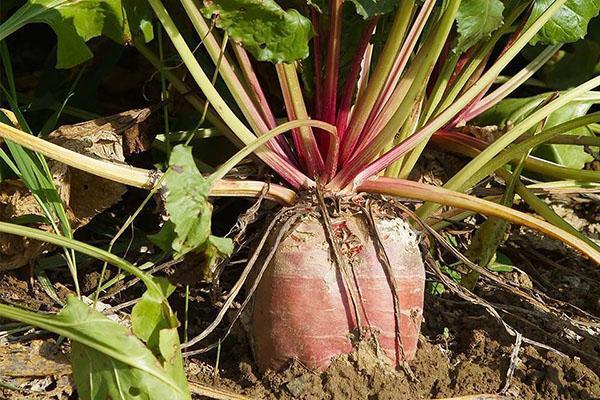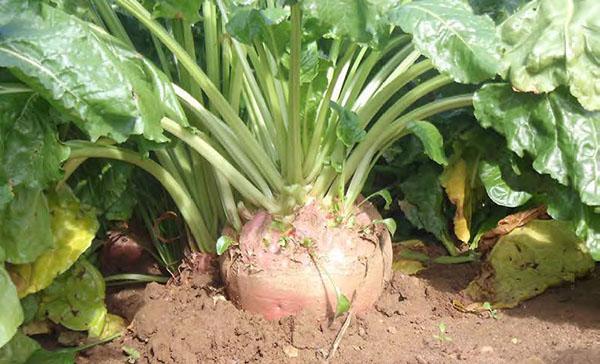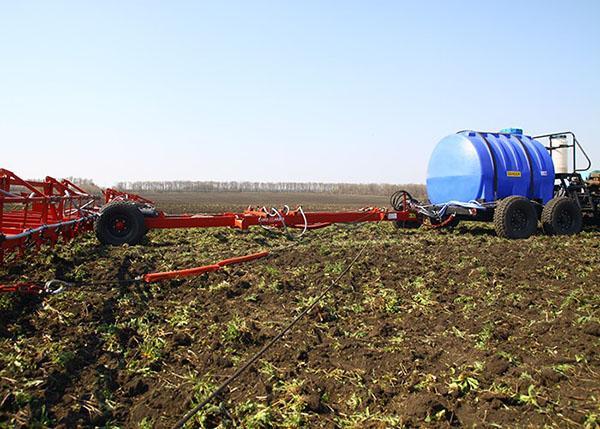Growing and caring for fodder beets is a simple agricultural technique, but with some nuances
 Millions of farmers know that growing and caring for fodder beets is the most profitable business in their work. Indicators of crop productivity, depending on the variety, can be from 85 to 1200 centners per hectare. In addition, the composition of the root vegetable contains many vitamins and trace elements that contribute to the digestion, as well as the rapid assimilation of dry feed. Moreover, in the summer months, animals can be given not only fruits, but also plant tops. In this regard, it is worth learning some of the nuances of planting and the features of caring for it.
Millions of farmers know that growing and caring for fodder beets is the most profitable business in their work. Indicators of crop productivity, depending on the variety, can be from 85 to 1200 centners per hectare. In addition, the composition of the root vegetable contains many vitamins and trace elements that contribute to the digestion, as well as the rapid assimilation of dry feed. Moreover, in the summer months, animals can be given not only fruits, but also plant tops. In this regard, it is worth learning some of the nuances of planting and the features of caring for it.
Fodder beets have been successfully used as a unique product that increases milk yield in cows and goats. At the same time, the vegetable does not harm the health of livestock at all.
Growing and caring for fodder beets

Such varieties of culture as Starmon, Tsentaur Poli, Nadezhda, Oberndorf Krasnaya, Milana, Lada and Jamon are especially popular among farmers.
To plant fodder beet seeds in open ground, you need to know several features of this process. Its germination depends on:
- structure of the earth;
- local climate;
- embedment depth;
- sowing time.
Agronomists recommend sowing an agricultural plant in early spring, as soon as the soil (at a depth of 8 cm) warms up to a temperature of + 6 ... + 7˚С. Often, the sowing dates for fodder beets are at the end of March or April 10-15.
Fertilizer complex - 50% success

Before planting, carefully prepare the site. The earth is dug up and loosened. To obtain a yield of 400 c / ha (root crops) and 100 c / ha (tops), for each hectare they apply:
- Nitrogen... For black soil, 60-70 kg will be required, for steppe soils - 30-45 kg, and for West Siberian territories - 80-90 kg.
- Phosphorus. The dosage in the central regions is 60-90 kg, in Siberia and the steppe regions - 40-45 kg.
- Potassium. The sequence of territories is the same as in the 1st point: 60-70 kg, 40-45 kg and 80-90 kg.
Thanks to such a scheme for introducing mineral mixtures, it is possible to increase the yield by 3-5 times. But even after that, the culture is threatened by pests. To avoid such an invasion, it is necessary to process beet seeds before planting using a solution of potassium permanganate. They are kept in such a disinfectant for about 30 minutes.
Fodder beet seeds are sown into grooves no deeper than 3-5 cm and with a step of 20-25 cm from each other. The row spacing is 50-60 cm.
Features of the care of fodder beets
 Each farmer tries to achieve high crop yields by spending a minimum of money, effort and time on growing it. For this reason, many gardeners are intensively studying the features of agricultural technology of fodder beets, and then introduce them into life.
Each farmer tries to achieve high crop yields by spending a minimum of money, effort and time on growing it. For this reason, many gardeners are intensively studying the features of agricultural technology of fodder beets, and then introduce them into life.
To begin with, they determine a worthy place for her in the crop rotation:
- Field variations. In the fields, the root crop is planted only after legumes, winter cereals, as well as row crops: corn, potatoes, sunflower or cabbage.
- Garden alternations.On personal beds, its predecessors can be melons, watermelons, zucchini, squash, pumpkins, cereals and legumes, as well as corn, which is grown for silage.
- Forbidden varieties. Planting fodder beets is not recommended after sugar beet, perennial grasses or Sudanese. It is recommended to plant it in its original place only after 4 years.
 After the first shoots appear, the bed is thinned out so that 4-5 seedlings remain on 1 running meter. If a crust has formed on the surface of the earth, then the area should be watered and the soil should be thoroughly loosened. Experienced farmers add ammonium nitrate with water in a ratio of 12 g / r.m.
After the first shoots appear, the bed is thinned out so that 4-5 seedlings remain on 1 running meter. If a crust has formed on the surface of the earth, then the area should be watered and the soil should be thoroughly loosened. Experienced farmers add ammonium nitrate with water in a ratio of 12 g / r.m.
After 14 days, it is desirable to carry out one more top dressing using other mineral fertilizers. Weeds should be harvested regularly until the tops of the mature plants are closed. The result of this cultivation and care of the fodder beet will be a juicy, nutritious root vegetable.
Often after sowing, the soil surface dries out and shrinks quickly. In such cases, 2 days after planting, it is necessary to walk along the aisles with a flat cutter (embedment 3-5 cm) so that oxygen penetrates into the soil. When using a hoe, the tool is placed across the furrow or at an angle of 30-40˚.
Watering the garden
 Particular attention should be paid to watering the land. The site is abundantly humidified throughout the summer, but to a greater extent when the air temperature rises to 30-35˚С. At the same time, rainy autumn also negatively affects the state of the crop. Therefore, in the aisles, it is imperative to make special holes to drain excess fluid.
Particular attention should be paid to watering the land. The site is abundantly humidified throughout the summer, but to a greater extent when the air temperature rises to 30-35˚С. At the same time, rainy autumn also negatively affects the state of the crop. Therefore, in the aisles, it is imperative to make special holes to drain excess fluid.
Diseases and pests, but not winners
 Not only pets, but also pests are always ready to feast on fodder beets. Often this culture is eaten by insects, as well as fungal diseases. The appearance on the leaves of brown spots, covered with a bloom, or a red-brown border indicate the defeat of the sprouts by cercospora.
Not only pets, but also pests are always ready to feast on fodder beets. Often this culture is eaten by insects, as well as fungal diseases. The appearance on the leaves of brown spots, covered with a bloom, or a red-brown border indicate the defeat of the sprouts by cercospora.
This "hospital epicrisis" includes other diagnoses:
- powdery mildew;
- rust;
- phomosis (zonal dried spots);
- downy mildew.
Preventive measures to combat phomosis begin with the usual seed dressing. They are covered with a wetting powder of polycarbacin (75%) in a ratio of 0.5 g of fungicide per 100 g of inoculum. Among other things, it recommends applying boric acid (3 g / m²) to impoverished areas.
 Farmers should be afraid of the appearance of bean aphids, beet bugs, weevils and fleas on the rosettes. To protect your planting from such "clients", it is recommended to regularly apply mineral fertilizers. During the autumn digging, some use compost with the calculation of 35-37 t / ha. In addition, they take out wood ash to the garden - 2 c / ha.
Farmers should be afraid of the appearance of bean aphids, beet bugs, weevils and fleas on the rosettes. To protect your planting from such "clients", it is recommended to regularly apply mineral fertilizers. During the autumn digging, some use compost with the calculation of 35-37 t / ha. In addition, they take out wood ash to the garden - 2 c / ha.
Harvesting fodder beets
 In the fields, a valuable crop is harvested using special agricultural technology: combines or potato diggers. At home, they dig it out with a shovel or pitchfork. However, a month before the start of such a harvest, you should completely stop watering the land. If the roots absorb a lot of liquid, then the sugar content in them will decrease, and this will negatively affect their keeping quality.
In the fields, a valuable crop is harvested using special agricultural technology: combines or potato diggers. At home, they dig it out with a shovel or pitchfork. However, a month before the start of such a harvest, you should completely stop watering the land. If the roots absorb a lot of liquid, then the sugar content in them will decrease, and this will negatively affect their keeping quality.
Root crops are removed from the ground very carefully. Any bumps or cuts are a humble start to the decay process.
After discussing the technicalities of this case, it's time to find out when to harvest the fodder beets.
Farmers identify 3 hallmarks of culture readiness:
- the presence of new and unusual formations on the bush;
- yellowed or withered leaves;
- the root crop has reached a volume corresponding to its variety.
At the same time, it is important to know that beets are very afraid of frost. Therefore, it should be dug out before the temperature drops.
Storage of fodder beets
 Many people know how difficult it is sometimes to store fodder beets. In too warm rooms, root crops become lethargic, and in insufficiently ventilated rooms, they are affected by various fungal diseases.The optimum temperature for their content is + 5˚С. Such conditions are often found in cellars, basements or earthen pits. If these rooms are too warm, then specially equipped storage facilities are built. Good ventilation and temperature conditions (1-2 ° C) guarantee excellent keeping quality of fruits.
Many people know how difficult it is sometimes to store fodder beets. In too warm rooms, root crops become lethargic, and in insufficiently ventilated rooms, they are affected by various fungal diseases.The optimum temperature for their content is + 5˚С. Such conditions are often found in cellars, basements or earthen pits. If these rooms are too warm, then specially equipped storage facilities are built. Good ventilation and temperature conditions (1-2 ° C) guarantee excellent keeping quality of fruits.
Some farmers use heaps for storage, which are installed in elevated areas with deep groundwater.
When building them, they adhere to the following parameters:
- maximum length - 30 m;
- width - up to 3 m;
- height - about 1.7 m.
A mound 170 cm high is made of vegetables. This mountain is densely covered with straw and then earth. The thickness of such a layer can be up to 60 cm.  At the same time, along the entire storage facility, an exhaust pipe is placed at the top, and 2 supply air ducts at the base, the distance between which should be about 150 cm.
At the same time, along the entire storage facility, an exhaust pipe is placed at the top, and 2 supply air ducts at the base, the distance between which should be about 150 cm.
A control tube and a thermometer are installed inside such a shoulder. These devices will help monitor the state of the microclimate inside the structure.
In the southern regions of the country, where the soil freezes later than usual and not very deeply, ground piles with pits (about 20 cm) are relevant. At this stage, the stage of growing and caring for fodder beets ends. Now the farmer only has to correctly calculate the harvest so that it will be enough for all the winter months.